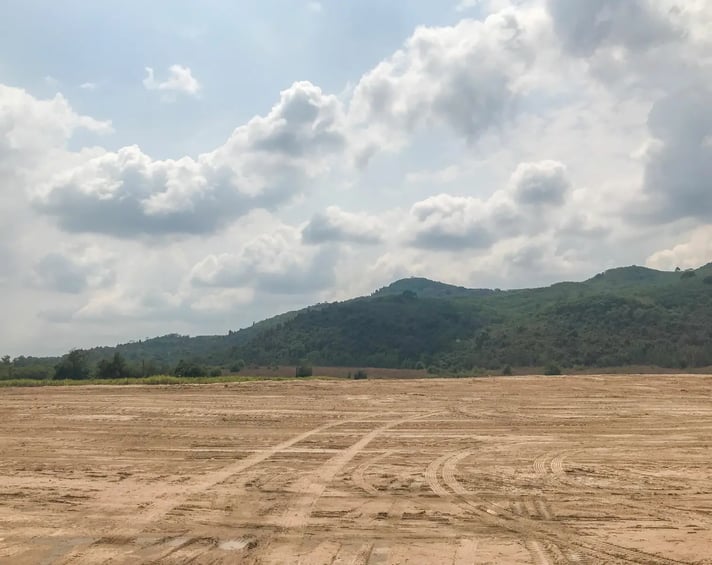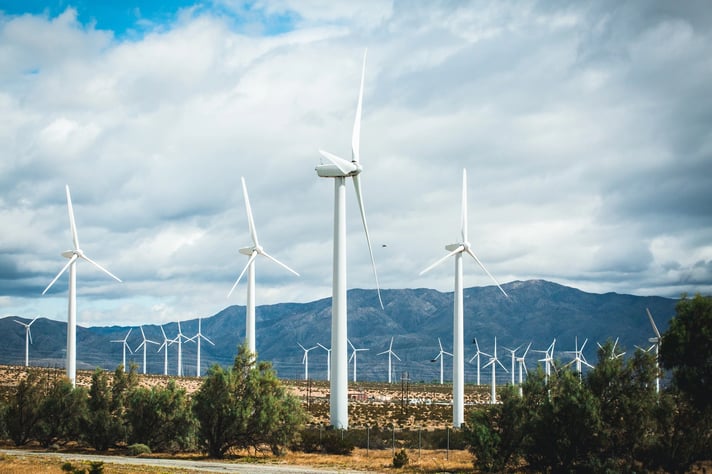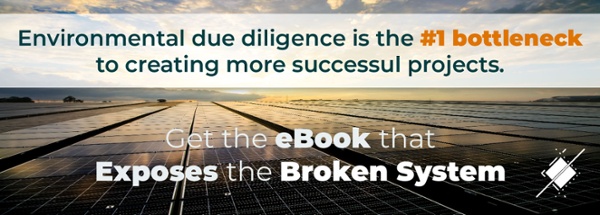.webp)
Listen to the audio version
It’s no secret that the world’s energy crisis is reaching epic proportions. From dependence on foreign powers for natural gas to skyrocketing prices at the pump, we obviously need a new solution to meet humanity’s constant energy demands without increasing carbon emissions.
For real, how’s a body supposed to warm up a toaster strudel without electricity??
Happily, wind power is a renewable energy source for which we now have mature technology and with which we have plenty of experience. Even more happily, the world is a windy place. From the top of Mt. Everest to the desolate reaches of the Mohave Desert, there’s plenty to be had.
Of course, those aren’t particularly close to interconnection points, substations, or power grids, so maybe they weren’t the best examples … which steers us nicely toward today’s topic: finding and securing wind farm development sites.
#transitionsftw
The Wind Industry: Steep Competition and Steeper All the Time
Wind developers have not been effing around lately. According to the International Energy Agency (EIA), “In 2020, onshore wind electricity generation increased by 144 TWh (+11%). Capacity additions increased an unprecedented 108 GW, twice as much as in 2019, mainly owing to a commissioning rush in China and the United States, which together accounted for 79% of global wind deployment.”
First of all, yay!
But.
What this admittedly delightful picture doesn’t paint quite as well is that this growth in wind energy technologies and generating capacity represents increasing competition all the time. With the creation of project development after project development, wind resources are rapidly growing while the available space for these projects remains the same. This truth has a natural consequence of a decreasing supply of ready-to-go sites. In other words, if you’re going to play the game, get ready to wrestle ever more intensely with those doing the same. The importance of understanding the steps to secure wind farm development sites, therefore, is critical.
We could never hope to cover the complexities of wind energy projects in a single post – we’re clean energy geniuses, not magicians. However, we’ve gathered the main steps of securing a wind farm development site to prepare you for your next battle.
Uh, project. We meant project.
Note: Offshore wind energy developers, this conversation isn’t for you. Our oceanic knowledge is almost entirely from behind-the-scenes videos of James Cameron exploring for the movie Titanic and that one scene in Jaws where they are in the tube, and you get to see all the different fishies. Great for coffee conversation, but not for understanding the steps it takes to develop an offshore wind farm...but when you drag that giant interconnect cable to shore and need to connect it to the grid....call us (After you remove your snorkel).

Step 1: Ensure Sufficient Wind Speeds in the Area
To harness wind power, you need wind. Crazy, right?
There are plenty of options lower than Mt. Everest and closer to utilities, you’ll be happy to know, but they still need to meet specific metrics. The most obvious of those is wind speeds.
“Good places for wind turbines are where the annual average wind speed is at least 9 miles per hour (mph)—or 4 meters per second (m/s)—for small wind turbines,” explain our friends at the EIA, “and 13 mph (5.8 m/s) for utility-scale turbines.”
There are plenty of places where you can find this information, from meteorological bodies to airport weather data, as well as databases kept by a local government or regional and state authorities. You know, like the U.S. Department of Energy, the American Wind Energy Association (AWEA), or the National Renewable Energy Laboratory (NREL). Heard of those guys? If a spot is much less than that, don’t bother.
Step 2: Understand Desirable Geographies
Energy systems and energy facilities need space to make your megawatt dreams happen. Many land-based geographical areas are suitable for wind farm land use. These include, but are not limited to:
- Hilltops and ridgelines with smooth topographies
- Open plains
- Gorges and other areas that funnel wind
Often, a potential wind site that fits this description exists within properties that are used for other purposes, such as agriculture, but cannot themselves be farmed due to topography or other limitations. What limits farming often won’t matter a whit for turbines and power plants.
Step 3: Establish a Market and Keep Upgrades in Mind
It goes without saying that to make money via wind energy generation, you need people to buy it from you. Upon locating a promising site, the next step in the site selection process is establishing demand (mindfully) and planning beyond just the power purchase agreement itself. Getting tax credits can be extremely helpful as well.
Why all this new age mindfulness hooey? Because even if you find a fantastic site, it might not be adjacent to an interconnection point, and you might need to add one. Or the transmission lines might need upgrading. Or the surrounding infrastructure might not yet suffice for building or adding the wind farm to the grid.
Balancing these factors with the installed capacity and the revenue you’ll generate once you’re in production is essential, so attend to them upfront.
Step 4: Understand Environmental Impact
Unfortunately, nothing in life is 100 percent good (barring onion rings, of course), including wind turbines. They do have some adverse environmental consequences, most notably when it comes to wildlife habitats.
Before committing, you need to ask the right questions, such as whether the site might jeopardize endangered or threatened species who fly through or live in the area. It’s not just direct collisions; noise and habitat loss can also impact local populations.
Other impacts include:
- Obstructing flight paths
- Negatively impacting local communities through noise
- Obstructions to views or visibility
- Shadow flicker (a condition in which turbine blades change the ambient light rapidly, which can be distressing for nearby residents)
That said, these issues are all very dealable-with (yes, that made sense). It’s simply not the case that wind farms can’t coexist with their environments. They can and often do productively.
Nevertheless, you can ensure greater productivity and a higher success rate by keeping such questions in mind during the scouting process. With your feasibility study in hand early in the development process, minimizing your mitigation efforts and the likelihood of being enemy no.1 of local crows for bird murder (they remember faces, so it’s best not to mess around) is possible.
Step 5: Choose a Business Model
There are many ways to access land for wind energy development. These include:
Purchasing it Outright
This option is usually not the most desirable for a few reasons. For one thing, it’s more expensive. For another, many properties suitable for wind power generation are also ideal for other purposes. With the growing human population, any opportunity to increase the density of our activities and preserve wild space around us is a good idea- except for those gas stations that combine showers and Pizza Huts. That’s the kind of density of which we just do not approve.
Leasing the Land
You can also lease the land from its owners, paying them a monthly rate to use it for the duration of the contract or until you sell its assets to them/someone else. You can also pay royalties.
Buying the Rights to Wind Power
If you or the stakeholders prefer, you can buy royalty rights to the wind instead. Rather than giving the landowner an ongoing lease payment or royalties, you can do the math to total the royalty rights for a set period of time and pay in a lump sum.

Step 6: Get Sign-On from Stakeholders
Sigh … meetings. Whatever path you choose, there will be meetings involved. But hopefully of the decisive, profitable variety!
Getting stakeholders on board means considering all sorts of angles to the project, such as:
- First and foremost, what form the land/rights purchase or leasing will take
- The use of heavy equipment in the area
- Investments needed to improve roads during construction
- Construction timelines
- How the local community feels (and possibly how they might help)
… and more. Bring the landowner in on this at the very outset, and you’ll have fewer headaches along the way.
There is one notable exception, however, which is that it’s always a good idea to do a quick preliminary evaluation of the land before approaching any stakeholders. That’s where Transect comes in.
Step 7: Talk to Transect Today
Assuming we didn’t scare you off the entire wind farm development process, we’ve got one more tip for you to put in your back pocket. Actually, scratch that. Make it your front pocket:
We are decommissioning the traditional environmental review process. Wherever possible, avoid traditional environmental consulting and opt for data-rich, bank-handy, ready-in-minutes desktop reports you can share with the team.
But, you’re thinking, surely such a miracle could never come to pass in my lifetime, good sirs, madams, and gentlepeople!
First of all, calm down.
Second, yeah … it’s real. Instead of working with consultants’ long timelines, antiquated systems, and sky-high rates, you can input parameters yourself and receive the information you need immediately. You can then share it with the whole team, your lender, or your cousin’s very smart Pomeranian. It’s a much faster way to assess sites and bring projects online than the old, unreliable, 20th-century consulting route. Plus, it reduces the many risks confronting green energy projects today. The environmental permitting process no longer has to be why you take up knitting classes for stress relief. Knowing how an existing transmission system or new energy policy will impact your project is just a click away. If the time saved and stress relief weren’t incentives enough, this system is also a fraction of the cost of traditional environmental due diligence.
Don’t believe us or want some additional information? Schedule a demo and become a believer. We’re ready when you are.

